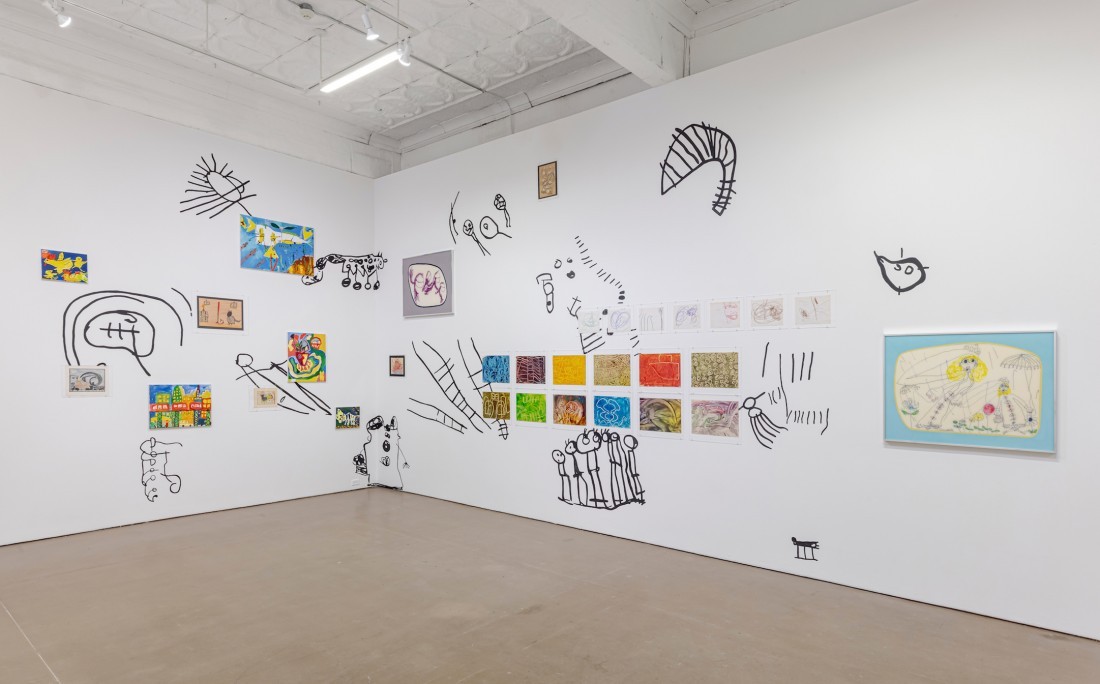Kids R’nt Us

Brian Belott, Dr. Kid President Jr., 2022. Installation view, “Evidence,” Mercer Union, Toronto, 2022. All photos: Toni Hafkenscheid. Courtesy the artist and the Rhoda Kellogg International Child Art Collection.
“The challenge for this exhibition was how do you make this work look serious but still let it do what it does best, which is to embody an unbridled spirit, the freedom which is what draws artists to it in the first place.” Paris-based Canadian curator Amy Zion is talking about “Evidence,” the exhibition she curated, combining children’s art with art by five adults at Mercer Union in Toronto this past summer. “We wanted to always work against the preconceived notions of what someone expects when they hear you’re going to have an exhibition of children’s art.” Instead of looking at children as archetypes or universal types, Zion wanted to introduce specificity in looking at children’s art. “The goal is to say that this specific child is giving you a glance into how they saw the world at this time in this place.” To make that specific point, “Evidence” paired a mural by Ulrike Müller modelled on WPA-era public art murals in the US with drawings done in the same period by children who had escaped the Spanish Civil War. The show also included drawings by Cree children attending a residential school in Alanis Obomsawin’s 1971 film called Christmas at Moose Factory.

Installation view, “Evidence” (with work by Petrit Halilaj and Alanis Obomsawin), Mercer Union, Toronto, 2022.
It is tempting to notice connections between the art by children and contemporary artists. The drawings of Jean N, a two-year-old who did a drawing every day for a year, conveniently fits the conceptual framework of artists like Marcel van Eeden, On Kawara and Jonathan Borofsky. But while Zion recognizes the similarity, she is wary of any aesthetic trap. “I’ve no interest in whether Jean N was a good or a bad artist and had total command of the page. What interests me is taking the material seriously. We give credence to the work of the children themselves, which is very different from modernist artists like Paul Klee and Picasso, who saw the drawings they collected as raw material for their own agenda. They were basically stealing inspiration.” Instead, Zion has put in her exhibition artists like Brian Belott, who, in his copies of children’s drawings from the Rhoda Kellogg International Child Art Collection, recognizes that what he is showing are “failures” and “forgeries” that can never measure up to the originals.

Installation view, “Evidence” (with work by Brian Belott, Petrit Halilaj, Ulrike Müller, Oscar Murillo), Mercer Union, Toronto, 2022.
There is a telling connection between two of the artists in the exhibition. Both Petrit Halilaj’s Abetare (NEVER APPLE) and Oscar Murillo’s Frequencies focus on the school desk as a point of departure for their art practice. For Abetare (NEVER APPLE), Halilaj returned to the school he had attended as a child in the village of Runik in Kosovo. The school was about to be demolished and he had children show him the tracings of generations of drawings on the school desks. He took them back to his studio and made steel sculptures from the drawings. They are awkwardly beautiful and utterly enchanting. Murillo gives schools in countries around the world canvases to cover their school desks and asks students to draw on them for the entire year. In the 10 years he has been overseeing the project, he has collected 40,000 drawings in 34 countries. There is something wonderfully subversive about taking the desk, the object of constrained learning in educational systems, and making it the location for unrestrained imaginative possibility.

Alanis Obomsawin, Christmas at Moose Factory, 1971. Installation view, “Evidence,” Mercer Union, Toronto, 2022. Courtesy the artist and the National Film Board of Canada.
In 1802 William Wordsworth wrote “My Heart Leaps Up,” which includes the line “The Child is father of the Man.” In nine short lines the poem establishes a continuity of inspiration that begins in childhood and connects through to old age. Amy Zion’s intelligent, delightfully rigorous and respectful curatorial projects that have included art by children have also been inspired by children. If we can escape the constraints of gender and accept that the child is father of the man, then we can also hope that in her future, the art the child makes will continue to be mother of the curator. ❚

